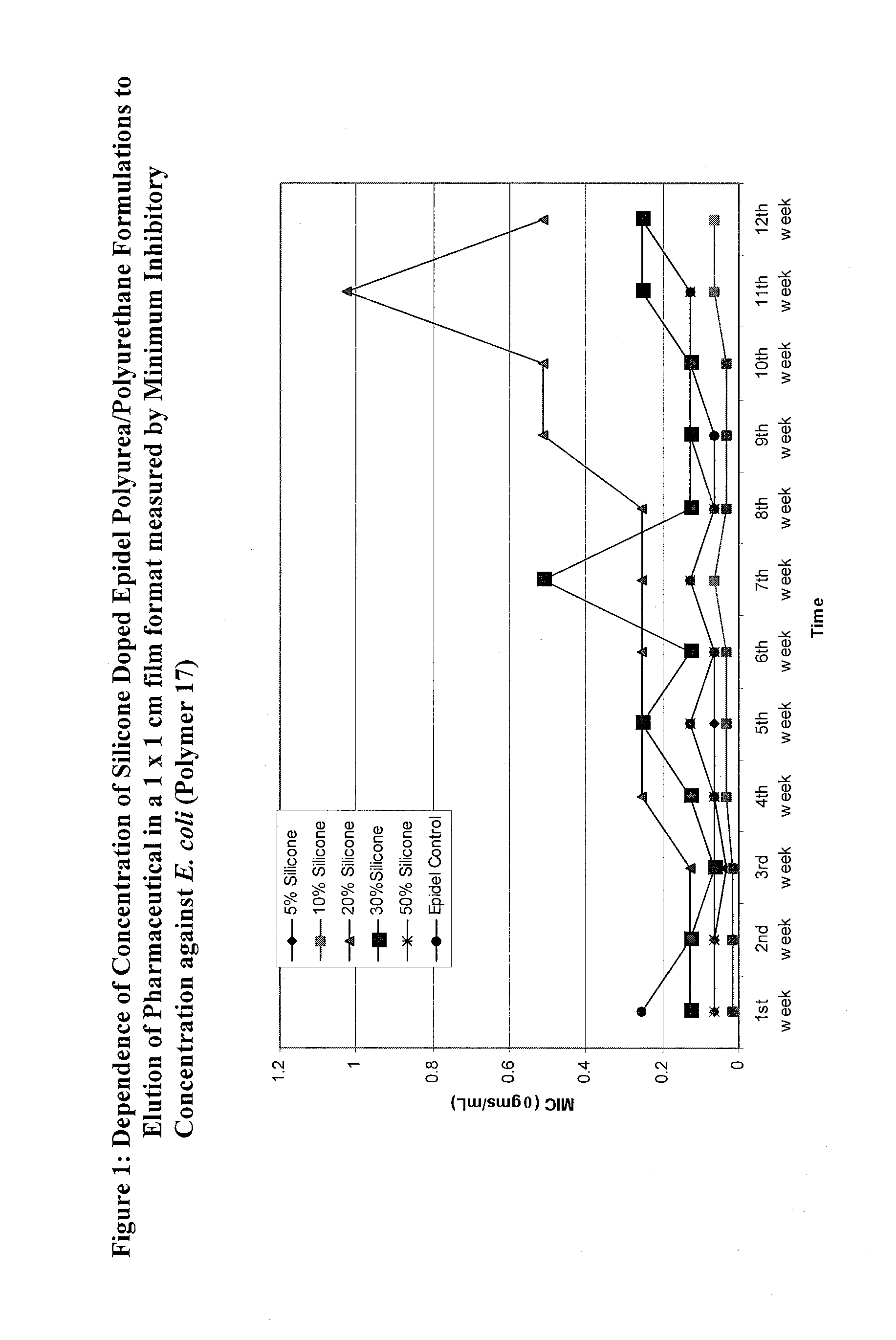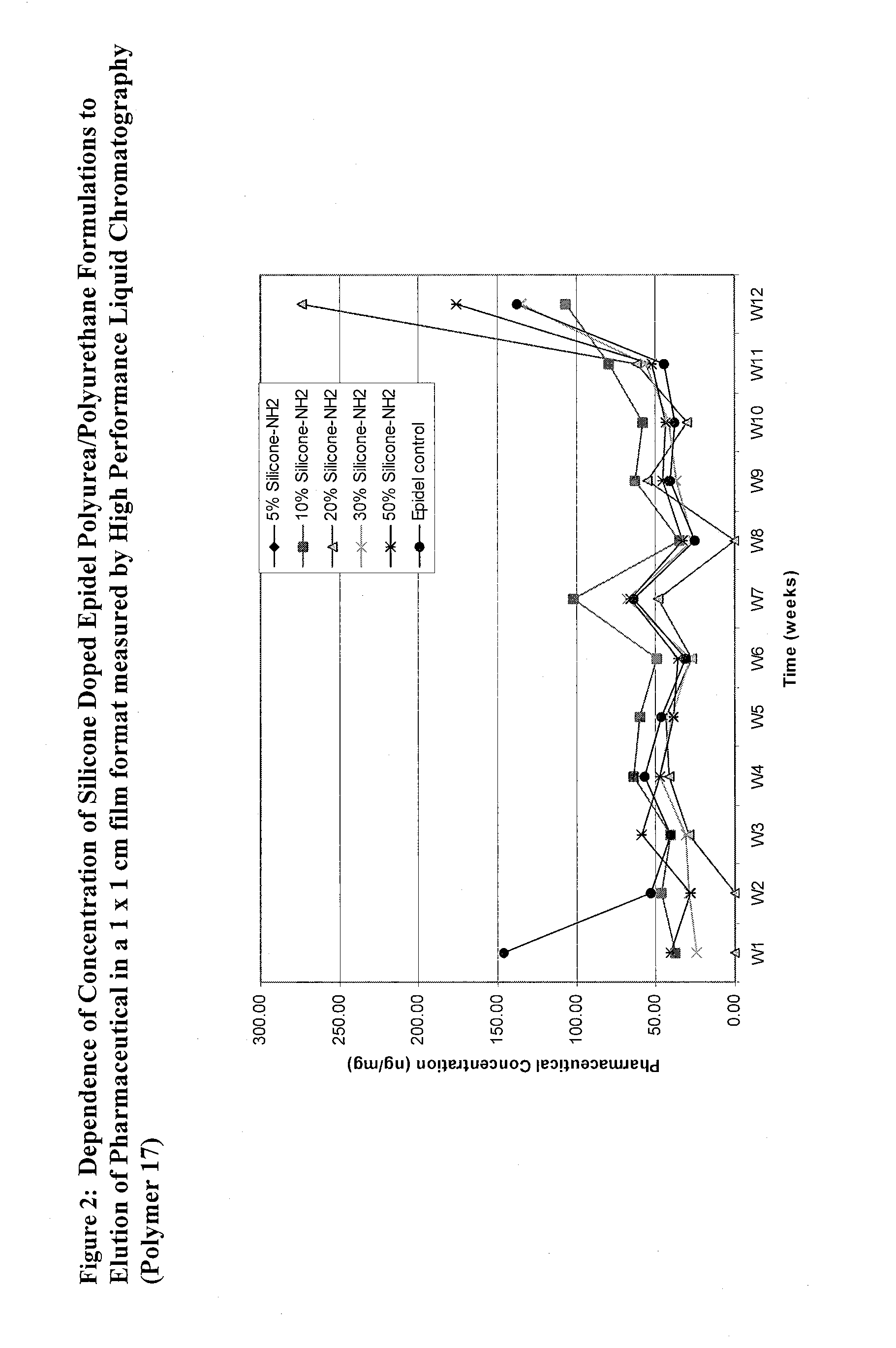Covalently grafted pharmaceutically active polymers
a polymer and covalent technology, applied in the field of covalently grafting pharmaceutically active polymers, can solve the problems of adversely affecting the mechanical properties of the shaped object, drug release beyond the optimal time frame, undesirable side effects in patients, etc., and achieve the effect of reducing possible adverse side effects
- Summary
- Abstract
- Description
- Claims
- Application Information
AI Technical Summary
Benefits of technology
Problems solved by technology
Method used
Image
Examples
example 1
Synthesis of Polysilicones Including an Activated Silicon Grafting Moiety with Amine End Groups
[0216]Polysilicones including activated silicon centers and amine end groups were used in the synthesis of graftable, pharmaceutically active polymers. A polysilicone including an activated silicon center as a grafting moiety was prepared according to Scheme 2. A polysilicone (Compound (8)) was treated with an amine-containing silicon reagent such as compound (9) to yield a polysilicone that has amine end groups (compound (2)). In this procedure, compound (8) was stripped of water by heating to 100° C. under vacuum (2-5 mm Hg) for 1 hour. The temperature was then reduced to 75° C. and aminopropyltrialkoxysilane (compound 9) was then added. The system remained under vacuum for 4 hours to remove the ethanol formed from the condensation process. A clear colorless fluid was then obtained. 1H NMR (400 MHz, CDCl3). δ: 3.75 (q, OCH2CH3), 2.64 (t, CH2CH2CH2), 1.19 (t, OCH2CH3, 0.00 (s, Si(CH3).
[02...
example 2
Synthesis of Polysilicones Including an Activated Silicon Grafting Moiety with Hydroxy End Groups
[0218]Polysilicones including activated silicon centers and hydroxy end groups may be used in the synthesis of graftable, pharmaceutically active polymers. A polysilicone including an activated silicon center as a grafting moiety may be prepared according to Scheme 3. A polysilicone (Compound (8)) may be treated with a hydroxy-containing silicon reagent such as compound (10) to yield an activated polysilicone that has hydroxy end groups (compound (4)).
[0219]
example 3
Synthesis of Polysilicones Including a Hydridosilane Grafting Moiety with Amine End Groups
[0220]Monomers including hydridosilanes are suitable for the synthesis of graftable, pharmaceutically active polymers and can be prepared according to Scheme 4. A silane reagent such as compound (11) can be used in a Pt-catalyzed hydrosilylation of an olefinic substrate such as an N-protected allylamine (compound (12)). The resulting product (compound (13)) may then be treated with a reducing agent such as LiAlH4 followed by N-deprotection to afford the desired hydridosilane product (compound (5)).
[0221]
PUM
| Property | Measurement | Unit |
|---|---|---|
| thickness | aaaaa | aaaaa |
| thickness | aaaaa | aaaaa |
| tensile strength | aaaaa | aaaaa |
Abstract
Description
Claims
Application Information
 Login to View More
Login to View More - R&D
- Intellectual Property
- Life Sciences
- Materials
- Tech Scout
- Unparalleled Data Quality
- Higher Quality Content
- 60% Fewer Hallucinations
Browse by: Latest US Patents, China's latest patents, Technical Efficacy Thesaurus, Application Domain, Technology Topic, Popular Technical Reports.
© 2025 PatSnap. All rights reserved.Legal|Privacy policy|Modern Slavery Act Transparency Statement|Sitemap|About US| Contact US: help@patsnap.com



